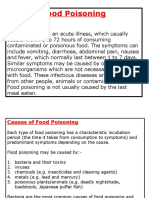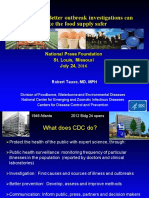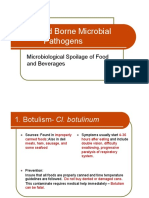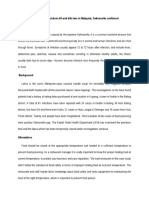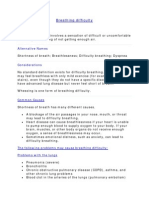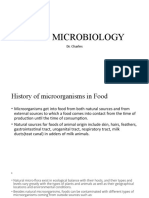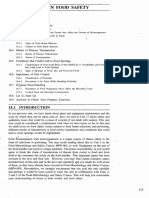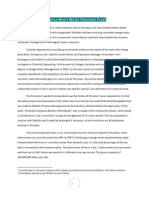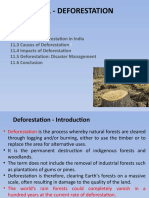0 ratings0% found this document useful (0 votes)
103 viewsDr. Joko Wahyu Wibowo Mkes
Dr. Joko Wahyu Wibowo Mkes
Uploaded by
Rangga Alam VaneoThere are thousands of cases of food poisoning reported each year resulting from poor food preparation or processing. Food poisoning can be mild or severe, with common symptoms including vomiting, diarrhea, and fever. Certain foods like meat, dairy, and fruit are high-risk for harboring microorganisms that cause food poisoning if the foods become contaminated and conditions allow the microorganisms to multiply. Proper handling and cooking of foods can help minimize the risk of food poisoning.
Copyright:
© All Rights Reserved
Available Formats
Download as PPTX, PDF, TXT or read online from Scribd
Dr. Joko Wahyu Wibowo Mkes
Dr. Joko Wahyu Wibowo Mkes
Uploaded by
Rangga Alam Vaneo0 ratings0% found this document useful (0 votes)
103 views51 pagesThere are thousands of cases of food poisoning reported each year resulting from poor food preparation or processing. Food poisoning can be mild or severe, with common symptoms including vomiting, diarrhea, and fever. Certain foods like meat, dairy, and fruit are high-risk for harboring microorganisms that cause food poisoning if the foods become contaminated and conditions allow the microorganisms to multiply. Proper handling and cooking of foods can help minimize the risk of food poisoning.
Original Title
Food Poisoning
Copyright
© © All Rights Reserved
Available Formats
PPTX, PDF, TXT or read online from Scribd
Share this document
Did you find this document useful?
Is this content inappropriate?
There are thousands of cases of food poisoning reported each year resulting from poor food preparation or processing. Food poisoning can be mild or severe, with common symptoms including vomiting, diarrhea, and fever. Certain foods like meat, dairy, and fruit are high-risk for harboring microorganisms that cause food poisoning if the foods become contaminated and conditions allow the microorganisms to multiply. Proper handling and cooking of foods can help minimize the risk of food poisoning.
Copyright:
© All Rights Reserved
Available Formats
Download as PPTX, PDF, TXT or read online from Scribd
Download as pptx, pdf, or txt
0 ratings0% found this document useful (0 votes)
103 views51 pagesDr. Joko Wahyu Wibowo Mkes
Dr. Joko Wahyu Wibowo Mkes
Uploaded by
Rangga Alam VaneoThere are thousands of cases of food poisoning reported each year resulting from poor food preparation or processing. Food poisoning can be mild or severe, with common symptoms including vomiting, diarrhea, and fever. Certain foods like meat, dairy, and fruit are high-risk for harboring microorganisms that cause food poisoning if the foods become contaminated and conditions allow the microorganisms to multiply. Proper handling and cooking of foods can help minimize the risk of food poisoning.
Copyright:
© All Rights Reserved
Available Formats
Download as PPTX, PDF, TXT or read online from Scribd
Download as pptx, pdf, or txt
You are on page 1of 51
dr.
joko wahyu wibowo MKes
Food poisoning
There are thousands of cases of food poisoning each year,
many of which are not reported or recorded in official
statistics.
Food poisoning may result from poor domestic food
preparation, or poor food processing in industry.
This may result in loss of business and peoples jobs if it is a
serious outbreak.
Food poisoning
Micro-organisms occur naturally in the environment, on
cereals, vegetables, fruit, animals, people, water, soil and in the
air.
Most bacteria are harmless but a small number can cause
illness.
Food which is contaminated with food poisoning micro-
organisms can look, taste and smell normal.
High risk foods
Some foods are high-risk, as they provide the ideal conditions
needed for micro-organisms to grow.
These include:
meat and meat products;
milk and dairy products;
fruit.
If these foods become contaminated with food-poisoning
micro-organisms and conditions allow them to multiply, the
risk of food-poisoning increases.
Symptoms of food poisoning
Food poisoning can be mild or severe.
The symptoms will be different depending on what type of
bacteria is responsible.
Common symptoms include:
severe vomiting;
diarrhoea;
exhaustion;
headache;
fever;
abdominal pain;
tiredness.
Antimicrobial substances
coumarins fruits and vegetables
lysozyme cows milk and eggs
aldehydic and phenolic compounds herbs and spices
allicin garlic
polyphenols green and black teas
Physical structure
grinding and mixing increase surface area and
distribute microbes
promotes microbial growth
outer skin of vegetables and fruits slows microbial
growth
General Principles
Minimize contamination by:
Good management processes
Acceptable sanitary practices
Rapid movement of food through processing
plant
Well-tested preservation procedures
Spoilage
Meat
Cutting board contamination
Conveyor belts
Temperature
Failure to distribute quickly
Fecal bacteria from intestines
Fish
Polluted waters
Transportation boxes
Spoilage
Poultry and Eggs
Human contact
Penetration by bacteria
Milk and Dairy Products
Lactobacillus and Streptococcus species that survive
pasturization (sour milk)
Breads
Spores and fungi that survive baking
Grains
Fungi produce toxins
Food-Borne Intoxications
ingestion of toxins in foods in which microbes have
grown
include staphylococcal food poisoning, botulism,
Clostridium perfringens food poisoning, and Bacillus
cereus food poisoning
Controlling Food Spoilage
Pasteurization
kills pathogens and substantially reduces number of
spoilage organisms
different pasteurization procedures heat for different
lengths of time
shorter heating times result in improved flavor
Canning
food heated in
special containers
(retorts) to 115 C
for 25 to 100
minutes
kills spoilage
microbes, but not
necessarily all
microbes in food
Detection of Food-Borne
Pathogens
must be rapid and sensitive
methods include:
culture techniques may be too slow
immunological techniques - very sensitive
molecular techniques
probes used to detect specific DNA or RNA
sensitive and specific
Epidemiology
Foodborne diseases each year in US
Affects 1 in 4 Americans
76 million illnesses
325,000 hospitalizations
5,000 deaths
1,500 of those deaths caused by Salmonella, Listeria, and
Toxoplasma
Center for Food Security and Public Health Iowa
State University 2004
Epidemiology
Many unrecognized or unreported
Mild disease undetected
Same pathogens in water and person to person
Emerging pathogens unidentifiable
Greatest risk
Elderly
Children
Immunocompromised
Center for Food Security and Public Health Iowa
State University 2004
Estimated Cost
Economic Research Service - USDA
Cost of top 5 foodborne pathogens
$6.9 billion annually
Medical cost
Productivity losses (missed work)
Value estimate of premature death
Center for Food Security and Public Health Iowa
State University 2004
Transmission
Oral route
Contamination varies
Organism, reservoir, handling/processing, cross-
contamination
Human reservoir
Norwalk-like virus, Campylobacter, Shigella
Animal reservoir
Campylobacter, Salmonella, E. coli 0157:H7, Listeria, and
Toxoplasma
Center for Food Security and Public Health Iowa
State University 2004
Transmission
Contamination can occur at several points along the
food chain
On the farm or in the field
At the slaughter plant
During processing
At the point of sale
In the home
Center for Food Security and Public Health Iowa
State University 2004
Important Organisms
Norwalk-like viruses
Campylobacter
Salmonella
E. coli O157:H7
Clostridium botulinum
Shigella spp
Toxoplasma
Emerging organisms
Center for Food Security and Public Health Iowa
State University 2004
Center for Food Security and Public Health Iowa
State University 2004
Norwalk-like Viruses
Small infectious dose
Signs
12-48 hours post-exposure
Nausea, vomiting, diarrhea, abdominal cramps
Headache, low-grade fever
Duration: 2 days
Food handlers should not return to work for 3 days
after symptoms subside
Center for Food Security and Public Health Iowa
State University 2004
Campylobacter jejuni
Leading cause of bacterial diarrhea
2.4 million people each year
Children under 5 years old
Young adults (ages 15-29)
Very few deaths
Can lead to Guillain-Barr Syndrome
Leading cause of acute paralysis
Develops 2-4 weeks after Campylobacter infection (after
diarrheal signs disappear)
Center for Food Security and Public Health Iowa
State University 2004
Campylobacteriosis
Sources
Raw or undercooked poultry
Non-chlorinated water
Raw milk
Infected animal or human feces
Poultry, cattle, puppies, kittens, pet birds
Clinical signs
Diarrhea, abdominal cramps,
fever, nausea
Duration: 2-5 days
Center for Food Security and Public Health Iowa
State University 2004
Salmonellosis
Gram negative bacteria
Many serotypes can cause disease
S. enteritidis and typhimurium
41% of all human cases
Most common species in U.S.
1.4 million cases annually
580 deaths
Center for Food Security and Public Health Iowa
State University 2004
Salmonellosis
Sources
Raw poultry and eggs
Raw milk
Raw beef
Unwashed fruit, alfalfa sprouts
Reptile pets: Snakes, turtles, lizards
Signs
Onset: 12-72 hours
Diarrhea, fever, cramps
Duration: 4-7 days
Center for Food Security and Public Health Iowa
State University 2004
E. coli O157:H7
Enterohemorrhagic Escherichia coli
(EHEC)
Surface proteins; toxin
Sources
Undercooked or raw hamburger; salami
Alfalfa sprouts; lettuce
Unpasteurized milk, apple juice or cider
Well water
Animals: Cattle, other mammals
Center for Food Security and Public Health Iowa
State University 2004
E. coli O157:H7
Signs
Watery or bloody diarrhea, nausea, cramps
Onset: 2-5 days
Duration: 5-10 days
Sequela
Hemolytic Uremic Syndrome (HUS)
Acute kidney failure in children
Life threatening
Center for Food Security and Public Health Iowa
State University 2004
Botulism
Clostridium botulinum
Neurotoxin leads to flaccid paralysis
Infants at greatest risk
Annually: 10-30 outbreaks; ~110 cases
Sources: Home-canned
foods, honey
Signs
Double vision, drooping eyelids, difficulty speaking and
swallowing
Onset: 18-36 hours
Center for Food Security and Public Health Iowa
State University 2004
Shigellosis
Bacillary dysentery
Most cases Shigella sonnei
90,000 cases every year in U.S.
Sources:
Human fecal contamination of food, beverages,
vegetables, water
Signs:
Watery or bloody diarrhea, nausea, vomiting, cramps,
fever
Onset: 2 days
Duration: 5-7 days
Center for Food Security and Public Health Iowa
State University 2004
Toxoplasmosis
Toxoplasma gondii- intracellular protozoan
112,500 cases annually
Pregnant women/immunocompromised at greatest risk
Sources
Infected cats, soil, undercooked meat
Signs
Fever, headache, swollen lymph nodes
Center for Food Security and Public Health Iowa
State University 2004
Bacteria - Clostridium perfringens
High risk foods
Raw meat, cooked meat dishes and poultry.
Signs and symptoms
Onset 8 22 hours. Abdominal pain, diarrhoea and
nausea. This usually lasts 12 48 hours.
Bacteria - Bacillus cereus
High risk foods
Rice, meat, seafood, salads, potatoes, and noodles.
Signs and symptoms
Ranges nausea and vomiting and abdominal cramps and
has an incubation period of 1 to 6 hours .
This usually lasts less than 24 hours after onset.
Bacteria - Listeria Monocytogenes
High risk foods
Unpasteurised milk and dairy products, cook-chill foods,
pate, meat, poultry and salad vegetables.
Signs and symptoms
Ranges from mild, flu-like illness to meningitis,
septicaemia, pneumonia. During pregnancy may lead to
miscarriage or birth of an infected baby.
Center for Food Security and Public Health Iowa
State University 2004
HEAVY METALS
The term heavy metal refers to any metallic chemical
element that has a relatively high density and is toxic
or poisonous at low concentrations.
HEAVY METALS
are natural components of the Earth's crust
they cannot be degraded or destroyed
to a small extent they enter our bodies via food, drinking
water and air
as trace elements, some heavy metals (e.g. copper,
selenium, zinc) are essential to maintain the metabolism of
the human body
however, at higher concentrations they can lead to
poisoning
heavy metal poisoning could result, for instance, from
drinking-water contamination (e.g. lead pipes), high
ambient air concentrations near emission sources, or intake
via the food chain
THE BIGGEST DISASTERS WITH A SPECIAL
APPEARANCE OF HEAVY METALS
1932-1952 Minamata
Sewage containing mercury is released by Chisso's
chemicals works into Minimata Bay in Japan. The
mercury accumulates in sea creatures, leading
eventually to mercury poisoning in the population.
In 1952, the first incidents of mercury poisoning
appear in the population of MinimataBay in Japan,
caused by consumption of fish polluted with
mercury, bringing nearly 1000 fatalities. Since
then, Japan has had the strictest environmental
laws in the industrialised world.
Environmental effects of mercury
Fish are organisms that absorb great amounts of
methyl mercury from surface waters every day
(mercury can accumulate in fish and in the food
chains)
The effects that mercury has on animals are:
kidneys damage, stomach disruption, damage to
intestines, reproductive failure and DNA alteration
Cadmium Cd
HEALTH EFFECTS
Human uptake of cadmium takes place mainly
through food
Foodstuffs that are rich in cadmium can greatly
increase the cadmium concentration in human bodies
(liver, mushrooms, shellfish, mussels, cocoa powder
and dried seaweed)
HEALTH EFFECTS
Diarrhoea, stomach pains and severe vomiting
Bone fracture
Reproductive failure and possibly even infertility
Damage to the central nervous system
Damage to the immune system
Psychological disorders
Possibly DNA damage or cancer development
Environmental effects of chromium
Most of the chromium in air will eventually settle
and end up in waters or soils
Chromium in soils strongly attaches to soil
particles and as a result it will not move towards
groundwater
In water chromium will absorb on sediment and
become immobile
Only a small part of the chromium that ends up in
water will eventually dissolve
Environmental effects of chromium
Chromium(III) is an essential element for
organisms that can disrupt the sugar metabolism
and cause heart conditions, when the daily dose is
too low
Chromium(VI) is mainly toxic to organisms - it can
alter genetic materials and cause cancer
Lead - Pb
Foods such as fruit, vegetables, meats, grains,
seafood, soft drinks and wine may contain
significant amounts of lead
Cigarette smoke also contains small amounts of
lead
Health effects of lead
Disruption of the biosynthesis of haemoglobin
and anemia
A rise in blood pressure
Kidney damage
Miscarriages
Disruption of nervous systems
Brain damage
Declined fertility of men through sperm damage
Diminished learning abilities of children
Behavioural disruptions of children, such as
aggression, impulsive behaviour and hyperactivity
Health effects of lead
Lead can enter a foetus through the placenta of the
mother
Because of this it can cause serious damage to the
nervous system and the brains of unborn children
That is why women in pregnancy can not work with
lead.
Environmental effects of lead
Lead accumulates in the bodies of water organisms
and soil organisms
Health effects on shellfish can take place even when
only very small concentrations of lead are present
Body functions of phytoplankton can be disturbed
when lead interferes. Phytoplankton is an
important source of oxygen production in seas and
many larger sea-animals eat it
That is why we now begin to wonder whether lead
pollution can influence global balances
You might also like
- Listado de Normas AocsDocument10 pagesListado de Normas AocsJosé Nemo Di Natale0% (1)
- Ordinance Regulating Meat Markets Wip - Final UnofficialDocument10 pagesOrdinance Regulating Meat Markets Wip - Final UnofficialKevin NambioNo ratings yet
- MALNUTRITIONDocument23 pagesMALNUTRITIONPrincess Alane MorenoNo ratings yet
- HACCP ConceptDocument19 pagesHACCP ConceptYasmine BekdacheNo ratings yet
- Health Benefits of Eating MuttonDocument4 pagesHealth Benefits of Eating MuttonAmal ami100% (1)
- Food Poisoning Fact FileDocument8 pagesFood Poisoning Fact FileAlpascaFirdausNo ratings yet
- Types of Food PoisoningDocument28 pagesTypes of Food Poisoningmtkhan52-1No ratings yet
- Hygiene: Food SpoilageDocument21 pagesHygiene: Food SpoilageIsharakh DoleNo ratings yet
- Food PoisoningDocument19 pagesFood PoisoningHemanathan PraemNo ratings yet
- Food Poisoning ADocument7 pagesFood Poisoning Aroyal highprinceNo ratings yet
- How Better Outbreak Investigations Can Make The Food Supply SaferDocument64 pagesHow Better Outbreak Investigations Can Make The Food Supply SaferNational Press FoundationNo ratings yet
- Lecture 1Document88 pagesLecture 1Jel John100% (1)
- Lecture 1 - FP2104Document38 pagesLecture 1 - FP2104Henriettah NakisoziNo ratings yet
- Food Borne Diseases and Its PreventionDocument181 pagesFood Borne Diseases and Its Preventionapi-19916399No ratings yet
- 004 Microbiological Spoilage of Food and Beverages PDFDocument69 pages004 Microbiological Spoilage of Food and Beverages PDFNadiya ShiyamahNo ratings yet
- Food Poisoning Sickens 60 and Kills Two in MalaysiaDocument2 pagesFood Poisoning Sickens 60 and Kills Two in MalaysiaEriwn CabaronNo ratings yet
- Fd7103 Food Processing and PreservationDocument1 pageFd7103 Food Processing and PreservationKevinXavier0% (1)
- Breathing DifficultyDocument13 pagesBreathing DifficultygivamathanNo ratings yet
- Food Borne InfectionsDocument19 pagesFood Borne InfectionsDr. Tha ThayumanavanNo ratings yet
- Bacterial Food IntoxicationDocument46 pagesBacterial Food IntoxicationAnonymous hTivgzixVNNo ratings yet
- Lecture 1. Sources of Microorganisms in FoodDocument23 pagesLecture 1. Sources of Microorganisms in FoodAnégria GahimbareNo ratings yet
- Nutrition SurveillanceDocument4 pagesNutrition Surveillancenimila gopiNo ratings yet
- Assessment of Nutritional SituationDocument24 pagesAssessment of Nutritional SituationMawasumi Ayu Andini0% (1)
- Principles of The Food Processing and PreservationDocument3 pagesPrinciples of The Food Processing and PreservationspidyNo ratings yet
- Amebiasis, Giradiasis, Helminths: DR Asim ShresthaDocument49 pagesAmebiasis, Giradiasis, Helminths: DR Asim ShresthaAsim ShresthaNo ratings yet
- Food FortificationDocument15 pagesFood Fortificationpranati100% (1)
- Hiv AidsDocument42 pagesHiv AidsISAACNo ratings yet
- Food SafetyDocument108 pagesFood Safetysham ibrahimNo ratings yet
- Components of The Immune SystemDocument8 pagesComponents of The Immune Systemبراءة أحمد السلاماتNo ratings yet
- AmebiasisDocument16 pagesAmebiasisNagendra NayakNo ratings yet
- Infectious Diseases: Robin Cochran-Dirksen (Many Slides From Bioedonline Baylor Christine Herrmann PHD)Document21 pagesInfectious Diseases: Robin Cochran-Dirksen (Many Slides From Bioedonline Baylor Christine Herrmann PHD)Aalia Azraei100% (1)
- Food AdulterationDocument15 pagesFood AdulterationTahreem ShaikhNo ratings yet
- Causes and Effects of Food SpoilageDocument34 pagesCauses and Effects of Food SpoilageAlex D100% (1)
- Food SafetyDocument6 pagesFood SafetyMary ann DeniegaNo ratings yet
- Dr. Sanjeev GuptaDocument73 pagesDr. Sanjeev Guptadrsanjeev15No ratings yet
- TyphoidDocument67 pagesTyphoidArnel L. SanicoNo ratings yet
- Created By: Michael Anthony C. Macaballug, R.NDocument115 pagesCreated By: Michael Anthony C. Macaballug, R.NRubyFranzCabangbang-QuilbanNo ratings yet
- BNF Food Poisoning Tcm4-662860Document23 pagesBNF Food Poisoning Tcm4-662860clinical_pathologyNo ratings yet
- Ecological AssessmentDocument10 pagesEcological AssessmentAL ImranNo ratings yet
- Classification of FoodDocument4 pagesClassification of FoodAbdul QuddusNo ratings yet
- Food Safety and SanitationDocument40 pagesFood Safety and SanitationLohith ShivannaNo ratings yet
- Food Preservation: Chemical Preservation: Dr. Pradeep PariharDocument30 pagesFood Preservation: Chemical Preservation: Dr. Pradeep PariharSmileeyNo ratings yet
- Food Poisoning Outbreak - LThaikrueaDocument24 pagesFood Poisoning Outbreak - LThaikrueaapi-26295875No ratings yet
- 1-4 Toxicants Resulting From Food Processing-2Document62 pages1-4 Toxicants Resulting From Food Processing-2dawitNo ratings yet
- Microbiology of MilkDocument27 pagesMicrobiology of MilkMohammad Ashraf Paul100% (7)
- Female Genital Mutilation: Definition Prevalence Classification Complications (Short Term & Long Term)Document13 pagesFemale Genital Mutilation: Definition Prevalence Classification Complications (Short Term & Long Term)tareNo ratings yet
- Food Poisoning Final Print!Document3 pagesFood Poisoning Final Print!Joeven HilarioNo ratings yet
- AMR Action Plan - Role of AcademiaDocument55 pagesAMR Action Plan - Role of AcademiaShonit Sharma100% (1)
- Lecture 1 - Primary Health Care OverviewDocument63 pagesLecture 1 - Primary Health Care OverviewِAli RabayaNo ratings yet
- International Health RegulationDocument62 pagesInternational Health Regulationsasmita nayak100% (1)
- Food Quality and Food Safety - NotesDocument15 pagesFood Quality and Food Safety - Notesnafofiv172No ratings yet
- Plant Sanitation 1Document11 pagesPlant Sanitation 1Mylene Alano PlacidoNo ratings yet
- Catering ScienceDocument2 pagesCatering ScienceNixon GeorgeNo ratings yet
- Food SpoilageDocument52 pagesFood SpoilageSatpal SinghNo ratings yet
- Overview of Food Quality by M.SivarajanDocument27 pagesOverview of Food Quality by M.SivarajanervaishaliNo ratings yet
- Food SafetyDocument39 pagesFood SafetyYan ŸanNo ratings yet
- Food PoisoningDocument11 pagesFood PoisoningLeanne Teh100% (1)
- MTP ActDocument22 pagesMTP Actsiddhpura.shivaniNo ratings yet
- Guidelines for Measuring Household and Individual Dietary DiversityFrom EverandGuidelines for Measuring Household and Individual Dietary DiversityNo ratings yet
- Intellectual Property Rights in Pharmaceutical Industry: Theory and PracticeFrom EverandIntellectual Property Rights in Pharmaceutical Industry: Theory and PracticeNo ratings yet
- Kuliah Gagal JantungDocument47 pagesKuliah Gagal JantungRangga Alam VaneoNo ratings yet
- "Broken Vow": (Chorus:)Document2 pages"Broken Vow": (Chorus:)Rangga Alam VaneoNo ratings yet
- Nutrition in Islamic PerspectiveDocument15 pagesNutrition in Islamic PerspectiveRangga Alam VaneoNo ratings yet
- Untitled 3Document1 pageUntitled 3Rangga Alam VaneoNo ratings yet
- Watson 120621Document1 pageWatson 120621vgplantsaleNo ratings yet
- Convergence Schemes for JKRLM under Various DepartmentsDocument14 pagesConvergence Schemes for JKRLM under Various Departmentsthokerarif302No ratings yet
- Chapter 9 - NPA PDFDocument98 pagesChapter 9 - NPA PDFSuraj ChauhanNo ratings yet
- 13 Series Industrial Grinder - BrochureDocument2 pages13 Series Industrial Grinder - BrochureAnil Kumar KnNo ratings yet
- FeedlotDocument18 pagesFeedlotanimrajabiy0310No ratings yet
- Varanasi DDP Report FinalDocument119 pagesVaranasi DDP Report FinalAakanksha MishraNo ratings yet
- GPB-232 SCOA, JainapurDocument123 pagesGPB-232 SCOA, JainapurKaran NNo ratings yet
- 11-0.4kV designDocument19 pages11-0.4kV designprem.ucs2081No ratings yet
- GuidelinesDocument8 pagesGuidelinesSHEILA MAY GESMUNDONo ratings yet
- Managua Waste Water Treatment Plant WootDocument5 pagesManagua Waste Water Treatment Plant WootpablolanzasNo ratings yet
- My Notes For Blg1502!1!1Document10 pagesMy Notes For Blg1502!1!1Pasipanodya MuzendaNo ratings yet
- MPA2EVB-11Deforest 12IndWasteDocument69 pagesMPA2EVB-11Deforest 12IndWasterajivekohliNo ratings yet
- Hand RollDocument2 pagesHand RollErdenetsogt SumiyasurenNo ratings yet
- 02 SynopsisDocument16 pages02 Synopsislucifer1711No ratings yet
- Durian Industries Limited - Durian Veneer CatalogueDocument66 pagesDurian Industries Limited - Durian Veneer CatalogueLokesh LokiNo ratings yet
- Finalazing Internship ReportDocument33 pagesFinalazing Internship ReportGhulam IshaqNo ratings yet
- Leasehold ContractsDocument13 pagesLeasehold ContractsJig-jig AbanNo ratings yet
- Evaluation of Water Equality of Major Rivers in Palawan Using Physico-Chemical Parameters and Water Quality IndexDocument13 pagesEvaluation of Water Equality of Major Rivers in Palawan Using Physico-Chemical Parameters and Water Quality IndexMark Ian EspirituNo ratings yet
- Plant CropsDocument18 pagesPlant CropsJamaica Jade MoredoNo ratings yet
- Govt. Women's Polytechnic College, Bhopal: Topic: Herbarium FileDocument31 pagesGovt. Women's Polytechnic College, Bhopal: Topic: Herbarium FileAnanya MehraNo ratings yet
- Processing Procedures of Brick Tea and Their Influence On Fluoride ContentDocument4 pagesProcessing Procedures of Brick Tea and Their Influence On Fluoride ContentikaredbutterflyNo ratings yet
- Wilderburbs: Communities On Nature's EdgeDocument36 pagesWilderburbs: Communities On Nature's EdgeUniversity of Washington Press0% (1)
- Harappan Civilization: B. I) It Was in Which Phase of History?Document38 pagesHarappan Civilization: B. I) It Was in Which Phase of History?Anup KumarNo ratings yet
- I Have A DreamDocument1 pageI Have A DreamWILDFIRENo ratings yet
- 11-Science Technology and Innovation StrategyDocument120 pages11-Science Technology and Innovation StrategyIPS Sri LankaNo ratings yet
- Design of CM CD WorksDocument20 pagesDesign of CM CD WorksVenkata Avinash Reddy100% (1)
- Tamil Translated Ques BankDocument7 pagesTamil Translated Ques Banklovealone1011No ratings yet
- LPM 121 FodderDocument133 pagesLPM 121 FodderHvk- 2062 Suhas C GNo ratings yet









